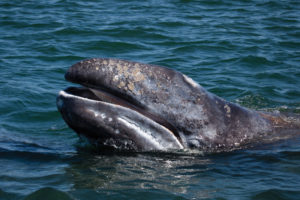The beginning of March is widely regarded as the start of gray whale season here in the Pacific Northwest, with Puget Sound acting as a prime viewing location. Grays hold a special place in the fabric of Pacific Northwest culture, as they are a coastal species of baleen (vs. toothed) whale that annually travels from Mexico’s winter breeding grounds to Alaska’s summer feeding grounds. To the delight of observers in the Pacific Northwest, females often have a calf in tow while heading up north this time of year. Their arrival between March and May is one of nature’s signals of spring’s arrival, not unlike the tulips of Skagit County, Washington or the spring Chinook runs.

Gray whales, unlike most other baleen whales that pursue swarms of plankton or small fish in the water column, are bottom feeders that sift through large mouthfuls of mud. With large adults reaching lengths of around 50′ and a weight of around 36 tons, they are said to typically live between 55 and 75 years.
Within Puget Sound, Saratoga Passage on the east side of Whidbey Island is a magnet for grays, and ferry goers on the Mukilteo Ferry often luck out with a sighting. Online, orcanetwork.org is a continually updated crowd-sourced resource for whale fans.
For boaters, it’s important to respect the law and space of the animals. If you see boaters harassing the whales, please straighten them out with a hail on the VHF. If they continue, report the incident to National Oceanic and Atmospheric Administration Enforcement at 1-800-853-1964. Be sure to take pictures and be ready to describe the vessel.